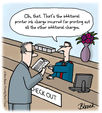Having Options
- Mo Lidsky
- May 23, 2017
- 3 min read
...excerpt from Mo Lidsky's latest book, Partners in Preservation

From the day they are born, children have a proliferation of synapses in the brain. Until the age of three, more and more synaptic connections are formed each day. A toddler is estimated to have as many as a quadrillion synaptic connections, more than double as many as adults. This allows children to be more flexible and adaptable than adults.
What follows in the years ahead is referred to as the process of Hebbian learning. As the child continues growing, the synaptic connections that they employ in their daily lives are strengthened, and those that they do not use get pruned. It is estimated that children proceed to lose as many as twenty billion synaptic connections each day. Michael Mauboussin points out that this process refines the brain, allowing it to survive and thrive in the specific environments in which we find ourselves. In More Than You Know, Michael Mauboussin explains:
“When the environment is uncertain, it helps to start with lots of alternatives (e.g. synaptic connections) and then select (via pruning) the ones that are best given the environment. The process is undoubtedly costly because lots of energy and resources necessarily go to waste, but it’s the best one going”.
This biological insight provides an equally significant message for both investors and advisors. Besides knowing about the best-in-class opportunities and having access to them, one must have a sufficient number of comparable alternatives from which to prune in order to make wise investment decisions.
In Smart Choices: A Practical Guide to Making Better Life Decisions, three management consultant gurus, John Hammond, Ralph Keeney, and Howard Raiffa, outline their view about how a good decision-making process should take place. They write that instead of using gut decisions, default options, or limited opportunity sets, individuals should always actively search out the best options or alternatives. Only then can they determine which best meet their objectives and proceed accordingly.
In deciding to remodel your kitchen, you would solicit proposals from several contractors and then review the quotes line by line, making sure you understood everything before hiring someone to come into your home because this has a direct and intimate impact on your life.
Although investing is not the same as having a carpenter in your breakfast nook in the morning, it should be approached the same; all options or alternatives should be considered before making a decision. Investors, however, have a tendency to select their first option, the default option, or some other reactive approach. This is true in the selection of advisors and the selection of investments. Investors may use an advisor from their community, participate in a real estate deal brought to them by their cousin, or invest in the business of a friend. Unfortunately, it is precisely this type of decision-making that leads people down the path of investing in mediocrity and away from the path of preservation.
It is somewhat intuitive that more options are better than none, but the extent to which that is true may be shocking. In a study of Fortune 500 senior executives, it was found that when executives considered more than one alternative, they made six times as many very good decisions (as opposed to those they rated “satisfactory” or “poor”). In his notable work The Most Important Thing: Uncommon Sense for the Thoughtful Investor, Howard Marks writes:
“Investment is a discipline of relative selection... First the process of investing has to be rigorous and disciplined. Second, it is by necessity comparative. Whether prices are depressed or elevated, and whether prospective returns are therefore high or low, we have to find the best investments out there. Since we can’t change the market, if we want to participate, our only option is to select the best from the possibilities that exist. These are relative decisions”.
This approach stands in stark contrast to the practice of large financial institutions, banks, and brokerage houses that manage to deploy 100 percent of the capital as soon as it walks through the door. This speed is a telltale sign of poor capital allocation.









Comments